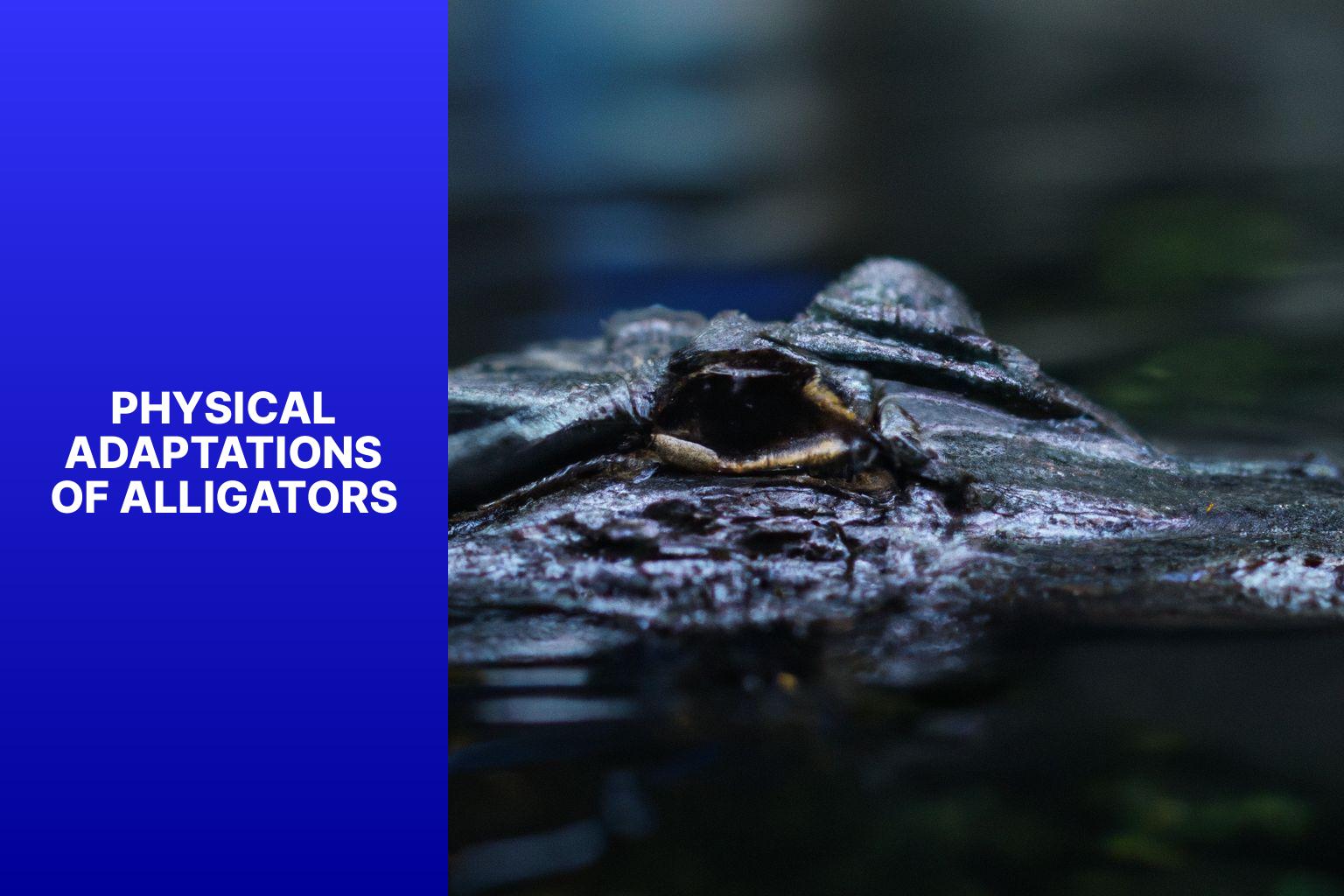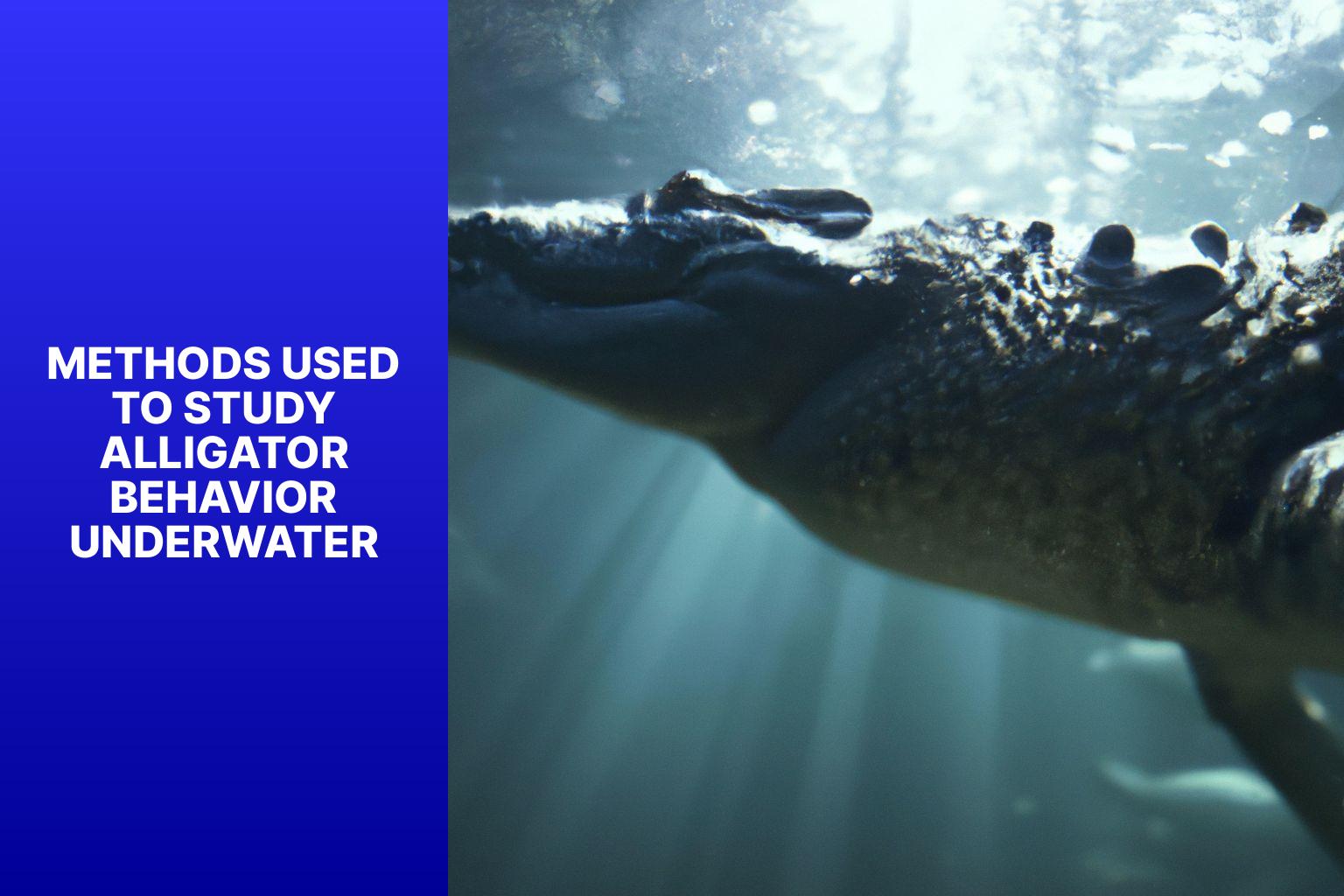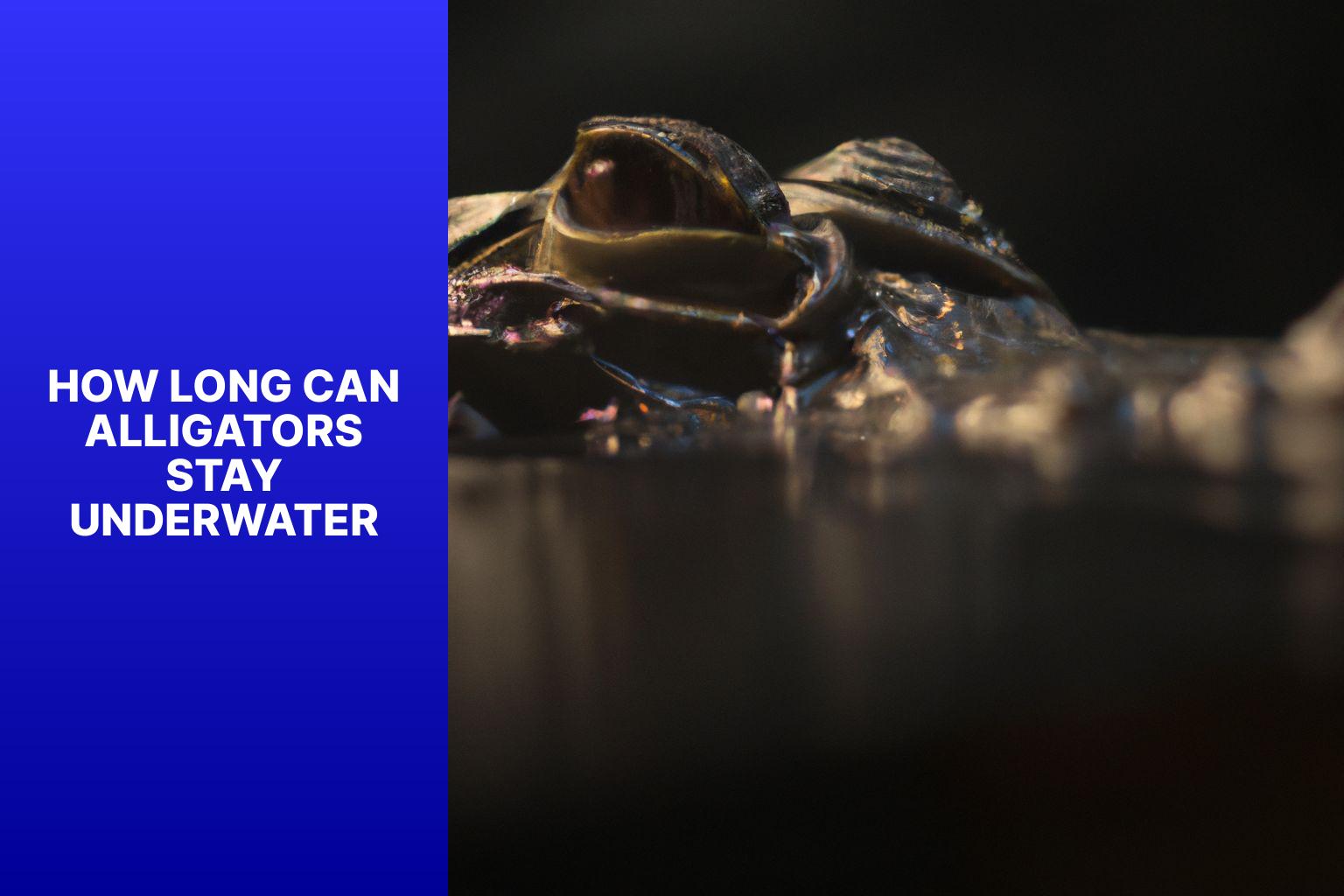Alligators, known for their remarkable aquatic abilities, have fascinating adaptations that allow them to stay underwater for extended periods. Understanding the physiological and behavioral aspects of alligators can shed light on their impressive submergence capability. This article will explore the physical adaptations of alligators, the duration they can stay underwater, methods used to study their behavior underwater, and survival mechanisms during extended submergence.
Physical Adaptations of Alligators:
- Respiratory System: Alligators possess specialized lungs and a unique breathing mechanism that enables them to breathe while submerged.
- Muscular System: Alligators have muscular tails and powerful limbs, which aid in propulsion and maneuverability underwater.
- Circulatory System: Their circulatory system exhibits adaptations that allow efficient oxygen transport to vital organs during extended periods of submergence.
How Long Can Alligators Stay Underwater?
The duration alligators can stay underwater is influenced by various factors, including behavioral and environmental aspects. Factors such as temperature, activity level, and size can affect their submergence time.
Methods Used to Study Alligator Behavior Underwater:
Researchers have employed various techniques to study alligator behavior underwater. Observational studies and telemetry tracking, utilizing sophisticated tracking devices, help scientists gain insights into their underwater movements and behavior.
Survival Mechanisms During Extended Submergence:
To survive during extended submergence, alligators rely on specific adaptations:
- Oxygen Storage: Alligators can store a significant amount of oxygen in their muscles and bloodstream, enabling them to sustain activity underwater.
- Decreased Metabolic Rate: Alligators exhibit a reduced metabolic rate while submerged, conserving energy and prolonging their submergence time.
By delving into the physical adaptations, factors influencing submergence time, research methods, and survival mechanisms, we can uncover the remarkable abilities of alligators and gain a deeper understanding of their underwater behavior.
Key takeaway:
- Alligators have physical adaptations that allow them to stay underwater for extended periods of time. These adaptations include a specialized respiratory system, muscular system, and circulatory system.
- The length of time alligators can stay underwater is influenced by both behavioral factors, such as their ability to slow their heart rate and conserve energy, and environmental factors, such as water temperature and oxygen levels.
- Methods used to study alligator behavior underwater include observational studies and telemetry tracking. These techniques help researchers understand how alligators navigate, hunt, and survive underwater.
- Alligators have survival mechanisms that enable them to thrive during extended submergence. These mechanisms include the storage of oxygen in their muscles and organs, as well as a decreased metabolic rate.
Physical Adaptations of Alligators

Photo Credits: Ruggedreptiles.Com by Logan Hall
Alligators have evolved remarkable physical adaptations that allow them to thrive both on land and in water. In this section, we’ll dive into the fascinating world of alligator physiology, exploring their respiratory, muscular, and circulatory systems. From their efficient respiratory system to their powerful muscular build, we’ll uncover the secrets behind their ability to navigate their aquatic habitats with ease. Prepare to be amazed by the incredible physical adaptations of these formidable reptiles.
Respiratory System
The respiratory system of alligators is highly adapted to their semi-aquatic lifestyle. Alligators, like mammals, possess lungs. They also have a unique characteristic called a bony secondary palate. This special palate enables them to breathe even when their mouths are underwater. When an alligator shuts its mouth, the bony secondary palate acts as a barrier between the throat and mouth, allowing them to swallow and digest prey underwater while still being able to breathe.
Alligators are capable of holding their breath for long periods of time due to their low oxygen needs. When submerged, they decrease their heart rate to conserve energy and minimize oxygen consumption. This ability allows them to stay underwater for approximately 10 to 15 minutes, although the exact duration varies depending on factors such as size, level of activity, and environmental conditions.
Understanding the respiratory system of alligators is essential for studying their behavior and survival strategies underwater. Through observational studies and telemetry tracking, researchers can gain valuable insights into how alligators navigate and thrive in their aquatic environment. By investigating the respiratory system of alligators, we can truly appreciate the incredible adaptations that enable them to remain submerged for extended periods, ultimately contributing to their overall survival in their natural habitat.
Muscular System
The muscular system is crucial for the survival and thriving of alligators. It enables them to swim, capture prey, and defend themselves effectively.
A well-developed muscular system allows alligators to move efficiently both on land and in water. Their strong limb muscles propel their bodies through the water with speed and agility. These muscles also provide the necessary strength for alligators to climb out of water and onto land, allowing them to navigate between their aquatic and terrestrial habitats.
The jaw muscles of alligators are formidable. They have a powerful bite force, essential for capturing and immobilizing prey. The jaw muscles can exert immense pressure, allowing alligators to subdue and consume a wide range of animals in their diet.
In addition to facilitating movement, the muscular system also helps regulate the body temperature of alligators. By contracting their muscles, alligators can generate heat, particularly important during cooler periods when maintaining internal body temperature is crucial for optimal functioning.
Alligators have an impressive muscular system that allows them to navigate their environment with ease and thrive in their habitats. Their muscles provide them with the strength, agility, and speed necessary for survival. Observing the incredible capabilities of the muscular system in these remarkable creatures is fascinating.
Circulatory System
The circulatory system of alligators is crucial for their survival and thriving in aquatic habitats. It comprises of the heart, blood vessels, and blood, which facilitate the transportation of oxygen, nutrients, and waste products throughout the alligator’s body.
Alligator hearts possess two atria and a ventricle, similar to other vertebrates. What sets alligators apart is their remarkable capability to regulate blood flow. They can prioritize blood circulation to vital organs and tissues like the brain and heart, while decreasing blood flow to non-essential areas like their limbs when underwater and oxygen levels are low.
Alligators possess a well-adapted network of blood vessels that deliver oxygen-rich blood to muscles and organs. These blood vessels also play a crucial role in controlling body temperature by distributing heat throughout the body.
In an intriguing study, researchers discovered that alligators can stay submerged for up to two hours. By monitoring heart rate and blood flow during these dives, scientists have gained valuable insights into alligator adaptations and their ability to survive in aquatic environments. This knowledge significantly contributes to our understanding of alligator circulatory systems and their impressive capabilities underwater.
How Long Can Alligators Stay Underwater?
Did you know that alligators are impressive when it comes to holding their breath underwater? In this section, we’ll dive into the fascinating topic of how long alligators can stay submerged. We’ll explore the various factors that influence their underwater endurance, including behavioral aspects and environmental conditions. Get ready to uncover the secrets of these remarkable creatures and discover the incredible lengths they can go to survive beneath the surface.
Behavioral Factors
Behavioral Factors in Alligator Underwater Behavior
1. Water Temperature
Alligators stay underwater longer in colder temperatures as their metabolic rate decreases and they require less oxygen.
2. Prey Availability
Alligators stay submerged for longer periods if there is an abundance of prey in the water. They patiently wait for unsuspecting prey to approach.
3. Predator Avoidance
Alligators remain submerged for extended periods if they sense the presence of potential predators, such as humans or larger animals, to avoid detection.
4. Breathing Habits
Alligators, being air-breathing reptiles, surface periodically to breathe. They can hold their breath for several minutes if necessary.
Understanding the behavioral factors that influence alligator underwater behavior is crucial for studying their natural aquatic habitat. Water temperature plays a significant role, with alligators opting for longer submergence in colder temperatures. Prey availability also affects their diving time, as they patiently wait for prey. Avoiding potential predators also influences their decision to stay underwater longer. While alligators are air-breathing reptiles, they can regulate their breathing and hold their breath for extended periods. By considering these behavioral factors, researchers can gain valuable insights into alligator survival strategies in aquatic environments.
Pro-tip: Alligators are fascinating creatures capable of adapting their behavior to their surroundings. By observing how they respond to different factors, scientists can deepen their understanding of their underwater behavior.
Environmental Factors
Environmental factors play a significant role in determining alligators’ ability to stay underwater. When considering alligators’ underwater behavior and physiology, several key environmental factors must be taken into account.
Firstly, water temperature is crucial. Alligators’ body temperature is dependent on the surrounding environment. In colder water, their metabolic rate decreases, enabling them to conserve oxygen and stay submerged for longer periods.
Next, oxygen availability in the water is essential for alligators’ survival. Warmer water tends to hold less oxygen, necessitating more frequent surfacing to breathe.
Water depth is another important factor that alligators can adapt to. Deeper water generally contains more oxygen, allowing alligators to stay underwater for extended periods without the need to surface.
Water quality also plays a role. Poor water quality, such as pollution or low oxygen levels, can have a negative impact on alligators’ ability to stay underwater. In such cases, alligators may need to surface more frequently to access oxygen from the air.
Finally, habitat characteristics are influential. Alligators require access to reliable water sources that include hiding spots and vegetation. These factors not only affect their underwater behavior but also influence the amount of time they spend submerged.
Understanding and considering these environmental factors is essential for studying and conserving alligators in their natural aquatic habitats. By recognizing the significance of these factors, we can better support the survival and adaptation of these incredible creatures.
Methods Used to Study Alligator Behavior Underwater

Photo Credits: Ruggedreptiles.Com by Jason Jackson
Discover the fascinating world of studying alligator behavior underwater with different methods. From observational studies to telemetry tracking, we delve into the techniques used to unravel the secrets of these remarkable reptiles. Prepare to dive into a wealth of facts, figures, and events that shed light on how long alligators can stay submerged. Get ready to explore the depths of alligator behavior like never before!
Observational Studies
Observational studies are crucial for comprehending alligator behavior underwater. Researchers diligently observe alligators in their natural habitats to acquire valuable information about their actions and interactions. These observational studies provide insights into the navigation, hunting, and socializing behavior of alligators underwater.
Observational studies involve closely monitoring alligators from a secure distance, whether it be from a boat or the water’s edge. Researchers utilize binoculars and cameras to document their observations. They make note of alligator movements, patterns of swimming, hunting behaviors, and interactions with other alligators or prey.
By conducting observational studies in the alligators’ natural environment, researchers can enhance their understanding of their behavior. This understanding can contribute to conservation efforts and the development of efficient management strategies.
If you are interested in learning more about alligators and their behavior underwater, consider visiting nature parks or wildlife reserves that offer guided tours or educational programs. These experiences present exceptional opportunities to observe alligators in their natural habitat and learn directly from field experts. Always prioritize safety and adhere to any guidelines or instructions provided by park staff.
Telemetry Tracking
Telemetry Tracking Table:
| Method | Description |
| Implantable Transmitters | Small devices implanted in alligators to track their movements and behaviors underwater. These transmitters transmit signals detected by receivers in the study area. |
| Aerial Telemetry | Researchers track signals emitted by transmitters attached to alligators using a combination of aircraft and receivers. This method allows for wider tracking over larger areas. |
| Acoustic Telemetry | Alligators are fitted with transmitters that emit ultrasonic signals. These signals can be detected by underwater receivers, enabling researchers to track alligator movements and behaviors in aquatic habitats. |
Telemetry tracking is a valuable method to study alligator behavior underwater. Implantable transmitters are small devices surgically implanted into alligators, allowing researchers to track their movements and behaviors underwater. Aerial telemetry uses aircraft and receivers to detect signals emitted by transmitters attached to alligators, providing broader tracking over larger areas. Acoustic telemetry uses transmitters emitting ultrasonic signals, which can be detected by underwater receivers, enabling researchers to monitor alligator activities in aquatic habitats.
Suggestions:
- Expand on the specific insights gained from telemetry tracking.
- Provide examples of studies conducted using telemetry tracking and their findings.
- Discuss the limitations and challenges associated with telemetry tracking in alligator research.
- Include information on how telemetry tracking has contributed to our understanding of alligator conservation and management.
Survival Mechanisms During Extended Submergence
During extended periods underwater, alligators have fascinating survival mechanisms that allow them to thrive. By storing oxygen and reducing their metabolic rate, these reptiles have adapted to survive in aquatic environments. Discover the remarkable ways in which alligators have honed their ability to sustain themselves underwater in this captivating exploration of their survival strategies.
Oxygen Storage
To understand alligators’ oxygen storage capabilities during extended submergence, we can examine the following data:
| Oxygen Storage Mechanism | Details |
| Lungs | Alligators have large lungs that can hold a significant amount of oxygen, supporting their extended time underwater. They can take in a large volume of air with each breath, maximizing their oxygen intake. |
| Specialized Blood | Alligators have hemocyanin, a special type of hemoglobin that is more efficient at binding and carrying oxygen than typical mammalian hemoglobin. This enhances their ability to store and transport oxygen throughout their body. |
| Low Metabolic Rate | Alligators can lower their metabolic rate during periods of inactivity. By reducing energy expenditure, they conserve oxygen and prolong their ability to stay underwater for extended periods. |
| Air Breathing | Alligators can breathe air, replenishing their oxygen supply when they surface. This allows them to stay submerged for longer without needing to return to the surface. |
Through these mechanisms, alligators are able to stay underwater for extended periods, typically ranging from 10 to 15 minutes. Their efficient lung capacity, specialized blood, ability to lower metabolic rate, and air-breathing adaptations contribute to their impressive underwater endurance. These factors allow alligators to thrive in their aquatic habitats, where they can hunt and navigate effectively.
Decreased Metabolic Rate
Alligators have a decreased metabolic rate that enables them to stay underwater for extended periods. When submerged, their metabolic rate naturally slows down, resulting in a reduction of their need for oxygen and energy. This unique adaptation conserves energy and allows them to remain underwater for hours or even days without the necessity to surface for air.
During this time, their heart rate, breathing rate, and overall activity level all decrease. The decreased metabolic rate enables alligators to slow down their bodily functions and decrease their usage of oxygen, which in turn enables them to stay submerged for different durations depending on the prevailing conditions.
This remarkable survival mechanism greatly aids alligators in thriving in their aquatic environment. By conserving energy and oxygen, they can patiently await prey, avoid predators, and effectively navigate their underwater habitat.
Pro-tip: It’s crucial to remember that an alligator’s decreased metabolic rate underwater does not make them any less dangerous. It is always important to maintain a safe distance and respect their natural behavior.
Some Facts About How Long Alligators Can Stay Underwater:
- ✅ Alligators can stay underwater for 20-30 minutes, but can stay submerged for up to 1-24 hours if necessary. (Source: All About Arkansas)
- ✅ Some sources state that alligators can stay underwater for no more than 2 hours. (Source: All About Arkansas)
- ✅ Alligators cannot breathe underwater and must come to the surface to breathe. (Source: All About Arkansas)
- ✅ Alligators may sleep for short periods of time while submerged or partially submerged, but they also sleep on the shore. (Source: All About Arkansas)
- ✅ When alligators sleep underwater, they keep their nostrils pointed up and out of the water to breathe. (Source: All About Arkansas)
Frequently Asked Questions
How long can alligators stay underwater?
Alligators can stay underwater for varying lengths of time, with some sources saying up to 24 hours and others saying about 2 hours. They usually only submerge for about 10 to 20 minutes at a time.
Can alligators hold their breath for a long time?
Alligators can ration their oxygen supply and slow their heart rate to only two or three beats per minute when submerging for extended periods. They “tank up” on oxygen at the beginning of a dive and use very little throughout the rest of the dive.
Do alligators have breath-holding skills like marine mammals?
Alligators have circulatory adjustments that allow them to control their blood supply and conserve oxygen. This enables them to stay submerged for longer periods without breathing.
What is the maximum time an alligator can stay underwater?
It is unclear exactly how long an alligator can hold its breath, with estimates ranging from 1 to 24 hours when necessary and 20 to 30 minutes on a regular basis. Factors such as age, health, and water conditions may affect this.
Can alligators breathe underwater?
No, alligators cannot breathe underwater as they have lungs, not gills. Even when they spend a long time underwater, they must eventually come up for air.
Why do alligators prefer to sleep in the water?
Alligators may sleep for short periods of time while submerged or partially submerged, as they feel more secure in the water. They often dig hollows in the mud to sleep in, allowing themselves to be partially in the water and partially on the shore.

